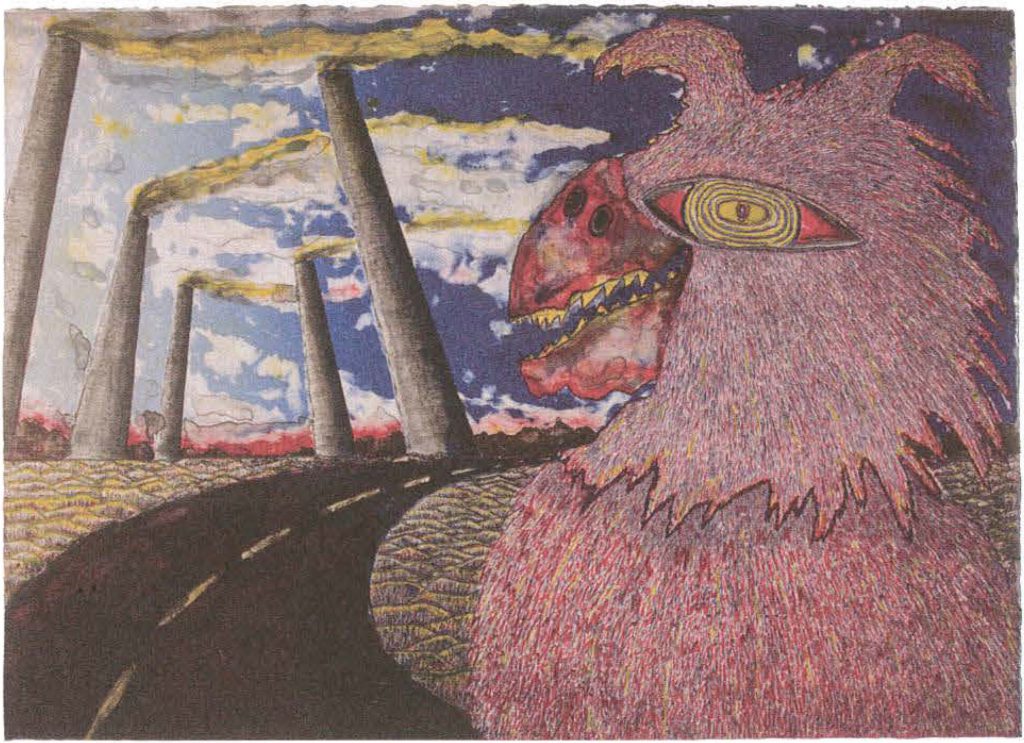
Watching
Elizabeth Grajales
- 1989
- Color offset lithograph
- Image/sheet: 21 5/8 x 30" (54.9 x 76.2 cm)
- 2009-61-33
About the Print
From the Artist
My work is always in a constant state of evolution. A print project will always allow for my individual aesthetic expression along with the potential of a mass media communicational force. The birds in my work are a vision from my dream world which I consciously decided to represent the conflict in our environment between nature and man’s tools of destruction.
—From Brandywine Workshop and Archives records“The earth is worth saving and … our destinies and that of the animals are intertwined.”
-Elizabeth Grajales, 1991
Billowing smokestacks, turbulent clouds, a fiery red horizon, and a deserted highway fill this barren landscape. What has happened? One living creature is around to tell the story. With the energy of a character from a computer animation, a lone bird (is it an eagle?) draws attention to its plight and to the destruction of the world that it inhabits. According to Grajales, “The birds in my work are a vision from my dream world … [they] represent the conflict in our environment between nature and man’s tools of destruction.” Grajales creates a stark contrast between the bird and nature and the man-made threats to them. Drawn in stippled, multicolored patterns and textures, the bird and landscape are presented almost as one. Although the bird dominates the foreground, the hard-edged monumentality of the giant stacks and the sharp curve of the never-ending, dark road make their harmful impact on the environment clear.
Let's Look
- What words would you use to describe the bird? What is it doing? What could it be thinking? What makes you say that?
- What is going on in the background?
- What has happened here? What might happen next? What clues does the artist give you?
- What do you think the bird's role in this story is?
- Grajales's work is often about the environment and people's impact on it. What messages might she be sending in this artwork?
About the Artist
Elizabeth Grajales, an artist of Latino heritage, studied drawing and painting at Arizona State University, where she was profoundly influenced by the mountainous setting and accompanying wildlife. She is best known for her mosaic panels When the Animals Speak, which were made for Penn Station in New York City and installed in 1998. Many millions of commuters have seen these murals that depict animal groupings and include birds, deer, bears, and lions. Grajales hopes that the images will give pleasure to the viewers as well as stimulate discussion about the environment and humans’ impact on nature.
Curriculum Connections
Suggested Topics for Art Projects, Group Discussion, and Independent Writing
Art
The Beauty of Nature
Elizabeth Grajales says the beauty of the Superstition Mountains of Arizona, where she studied drawing and painting, has influenced her work. According to an Apache legend, a hole leading down into the lower world is located in the Superstition Mountains. Winds blowing from the hole are said to be the cause of severe dust storms. Create a work using patterns and colors from torn magazines to create a collage that depicts this belief.
Compare and Contrast Artworks
Grajales and Hock E Aye Vi Edgar Heap of Birds have both created works of art that draw attention to issues important to them. Compare and contrast their prints. How are they similar? How are they different? Track your findings on a Venn diagram. Discuss why each artist may have chosen to represent their issue in the way that they did.
Language Arts
PowerPoint Presentation
Working in a small group, research, document, and find images online to make a PowerPoint presentation about an environmental issue important to you. Make an oral presentation to the class.
In Your Opinion
Consider Grajales's quote (page 28) about her artwork. In your opinion, does Watching reflect the spirit of her words? How? If not, why not?
Social Studies
Concept Proposal for an Environmental Mural
Research environmental issues such as air, water, and land pollution and their impact on ecosystems. Sketch and write notes based on research, and then create a proposal for a mural that expresses the importance of conservation and protection of natural resources.
